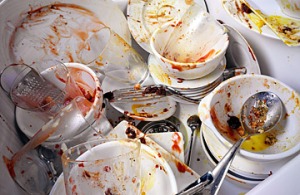The wonders of feeling served, cared for, and looked after represent some of our greatest life experiences. Even when we are physically ill, good rest and wholesome care help us to achieve that piece of mind and marvelous plateau of comfort. These actions display the gifts of unconditional love and they can eventually lead to true healing.
One of the most brutal aspects inside the culture of modern capitalism has been its perversion of such care. Whether they have the names of ‘health care, culinary centers,’ or ‘festival parks,’ capitalism has mugged and institutionalized the older enchantments of strong familial relations and community bonds into their profit-making enterprises.
These institutions have even gone farther into the crimes of legal theft and profiteering. The occult history of restaurants actually began in China during the 1200s, and for our modern restos, in France during the 1700s.
On a rough day in 1760s Paris, a coarse gentleman was clumping in the thin, narrow, cobblestone and nasty dirt, medieval streets of the city. The season was the beginning of an early winter in late November. The cold air was dead with frost, yet whips of cool wind fury could brutally bite the toughest soldier. He was also walking during the ratty, early morning hours. The sky had possessed an overcast grey muddy tinge that led to more foreboding.
The man wore his black hair in long locks with a tail at the end. He was clothed in an overcoat, a vest, a white blouse shirt, and unlike other wealthier men at the time, had on worker pants, while his long black leather boots covered his lower pant legs. He was of medium height, mostly clean-shaven, except for a permanent stubble on the chin and cheeks, and his face had that look of deep thought mixed with the pains of human suffering. He suffered from a mysterious illness inside his belly, a common ailment for that historical time.
He was actually walking to a ‘restaurant,’ a specialized medical dining hall that would hopefully ‘restaurer,’ or restore his health. There were a few in Paris, and this one was famous for its large spoon and bowl over the front door that advertised its palliative care. In those days, they still didn’t use numbers for specific addresses.
When he finally arrived at the care place, there were already a group of men, women and children sitting at the common table. The common table had the name of ‘table d’hôte,’ or the host’s table. He sat down at the end and already felt a nagging feeling.
The hostess suddenly slammed the large soup containers, hard bread, and salt in the middle of the large wooden, dirty table. The center mass of sick people began to hog the soup for the best choices of boiled chicken scrap, ‘bouillon,’ or broth, and seasonal cooked veggies. The bowl went around the table and so the people at the ends had to deal with what was left over. Eating at these places was often a surprise, since the meals often sat for a long time in large pots over the kitchen fire. Such was the ‘pot luck’ in those days. The tired man ate his food and paid his usual cheap ‘écus’ for the simple fare.
He also noticed some out-of-town travelers from the provinces at the table. The hostess charged them the ‘traveler’ fee, which was more expensive. He felt lucky in that he was a ‘Parisian’ local and knew the going rate. Until this very day, many restaurants are notorious for trying to fleece and legally rob unwary customers and out-of-town visitors.
This type of restaurant lasted until the French Revolution of the 1790s. By the beginning of the nineteenth-century, the 1800s, unemployed cooks that had previously worked for the parasitical ‘aristocrats’ began to advertise their culinary skills. If they had any capital, they could open a ‘restaurant’ for the ‘bourgeoisie,’ or upper class, owner-elites. These elites wanted to taste the exquisite plates from the previous epoch of sensual-gluttonous, aristo dining, represented by ten course meals.
The cooks offered ‘menus,’ or selected plates for the day at fixed prices and at certain eating times of the day. The cook owners cut up the tables to make sure there was greater privacy for the paying diners. Such was the birth of the modern restaurant that still spits out its notoriety.
Fine restaurants have continued to thrive as the ultimate conspicuous show of elitism and consumption. The wealthy elites can eat the ‘fine food,’ and enjoy the restaurant ambience, while they thumb their noses at the lower classes that cannot often afford to dine out.
Restaurants would soon perfect their harsh, capitalist division of labor. First came the owner, then the day-to-day manager, next the hot cook, or main cook, ‘le chef,’ and later, the front staff, waiters and hosts, or ‘serveurs.’ and finally the rest of the back staff – busboys, prep and assistant cold plate cooks – and the lowly dishwasher-general cleaner. But in China, five hundred years earlier, the restaurant existed as the extension of the spice and food market.
During the Sung dynasty in China, around the 1230s, this political dynasty had constructed a new capital and market center called Hangzhou. Hangzhou was not an ordinary city for those times. This megalopolis sold every type of imaginable fish, meat, vegetable and fruit – and most importantly, herbs and spices. Within the massive market, the traveler could find Muslim merchants coming from their routes in Africa and Asia, and even well-traveled Jewish merchant traders resided in the city. Famous world travelers visited the site, such as Marco Polo and Ibn Battuta. The city was also the most populous city in the world with over one million inhabitants.
Within the canal and urban jungle labyrinth of markets, buyers and sellers, the visitor could taste the culinary wonders of the world. The majestic stories were quite famous concerning the beautiful city on the lake and the green hills surrounding it. The wonderful foods, tastes, exotic sights, stalls, markets, herbs, smells, and spices enchanted Europeans accustomed to the harsh medieval cereal, legume and vegetable diet.
European elites began to desire a more refined table and palette, and they also wanted more culinary art diversity and a regular diet of diverse meats and fishes.
Local food preparers in Hangzhou prepared stuffed dumpling delights, and mixed noodle and soup plates. These European elite desires for the gourmet plate led to the colonial sea race in order to find another maritime route to India, China and the South Seas, (or the South China Sea lands of Malays, Siamese, Khmers, Laos, and Annam-Champa, or Vietnam).
Six hundred years later, elite Europeans would become the colonial-imperial curse on the Earth. European elites had idolized the sensuality of food over the healthy and hearty diet of the European peasant. The display of wealth and class power had trumped the warm feeling of family and community around a simple, yet tasty fare.
Our modern restaurant is the sacred symbol of food idolatry, small time savage capitalism and the fraudulent display of class position. The resto ultimately serves the rich and lazy that refuse to cook for themselves. The elites want the culinary arts that come with money, yet they refuse to do the labor. Someone else must labor, and labor mercilessly, in order for the money people to enjoy the experience – and the profiteering.
This vice is especially true for the restaurant owners. They might know a lot about food, and a few might even have worked as chefs before, but their main hankering is for a profit, or taking advantage of the mark, or customer, and the laboring staff. If this means buying cheap, genetically modified wholesale food for consumption, leaving out side dish food in metal canisters with plastic wrap for over a month, charging triple prices for cheap drinks, or even taking half-eaten food scraps and putting them in the general use bins – they will do it. The restaurant owner truly wants to make a profit, not feed humanity out of love.
Some restaurant owners have never done kitchen work in their lives. They simply inherited the joint from their parents, or as small time capitalists, they went into restaurant work because they thought that the money would come quickly and easily. They often hire their friends and buddies from previous business ventures, and who also know very little about food and drinks, to manage the dives. Woe unto the service workers that have to deal with these restaurant hells. If the city health inspectors really did their jobs, they would close those rancid places down.
US Restaurants often attract the most vicious, petty, mean, and cheap bosses from the small business owner class, or the petit bourgeoisie. Due to the heavy use of cash, the restaurant racket, like construction, can easily hide the underground economy, or ‘under the table’ money, from the government. In America, the owners can get away with paying a slave wage to the front staff, since the marks, or the customers, are partly required to pay the servers’ wages through ‘tips.’
Also in America, restaurants like construction, hotels and cleaning services, are the mainstays in hiring illegal immigrant workers, In restaurants, they all tend to work and stay hidden in the back kitchen. If the kitchen workers complain, then a call to the Immigration Service will suffice. I have even seen with my own eyes, Latino-mestizo workers from Mexico, Honduras and El Salvador doing the hot cooking in varied ethnic restaurants, such as Indian, Japanese, French, Ethiopian and Thai places!
I have my own personal work stories. When I was younger, I only worked in the back kitchen as a dishwasher for the desperation of needed travel money. I usual bolted when I had made enough cash, or the managers just fired me for religiously taking my breaks. I noticed that many of the young cooks were serious hard drug addicts and a few even sold hard drugs from the back doors.
The waitresses also acted nasty and rude. There were some serious infighting and petty hatreds between the cooks, hosts and servers. The restaurant boss had successfully used the old divide and conquer strategy. No wonder coffee was always free to the wage and tip slaves. Worker turnover was always high.
The workers often counterattacked by making deals with the bartender, including sleeping with him or her, in order to cop free drinks – after the lazy owner went AWOL from the job. The cooks stole copious amounts of food for their own late night deep-frying. The petty and pathetic servers with bad attitudes even made fun of the regular customers to the other staff, who generally ordered their usual meals and drinks – and yet tipped those assholes well.
Some Anarchists counter the anti-restaurant arguments by arguing in favor of vegan-cooperative ventures, or small, family owned restaurants and ethnic food enclaves. But these restaurant options suffer from the same diseases of capitalism – making more money.
If all restaurants use funny money, than they have to make some base profit in order to survive. In family ethnic restaurants the bosses are still bosses and often demand that all the workers share their tips with the owner, which is one of the last holdouts of feudalism. In order for alternative coops to make money, they have to cut corners too, and especially with food freshness. Vegetarian-vegan hipster cooperatives are often the worst abusers of reusing old breads, rice, millet and quinoa, and nuking pre-prepared plates, often made a few days ago, inside of their multiple microwaves – so much for freshness.
If a regular customer that likes to go out to eat and could see inside the actual kitchens and operations of restaurants, then he or she would refrain from visiting them regularly. The real issue, and especially for us Anarchists, is not succumbing to the vicious culture of global capitalism. We continue to pay the servers through our tips in order to help a cheap small business owner make a profit.
We could do the cooking labor at our homes, or at someone else’s house where the fare is often better than the resto variety. At least we know the freshness content of the food we are using. Cooking is also an art, and it is open to all of us humans, since we all do art in some form. Eating out is quite expensive too.
In our contemporary world, we cannot simply avoid restaurants and ban them completely from our lives. But we can cherish those special visits and occasions at our local eating place with family and friends and during festivities.
For those of us that travel, we often have no choice in the matter. If we are in a foreign country, then we would also want to try the local dishes. Youth hostels offer a good option for travelers since most of them have shared kitchens for guests.
We should always remember that the modern restaurant began as an informal medical place for the sick. If we are alive and still healthy, then let’s control our own food consumption and share the cooking within our own families and among our own small, friendly communities.





